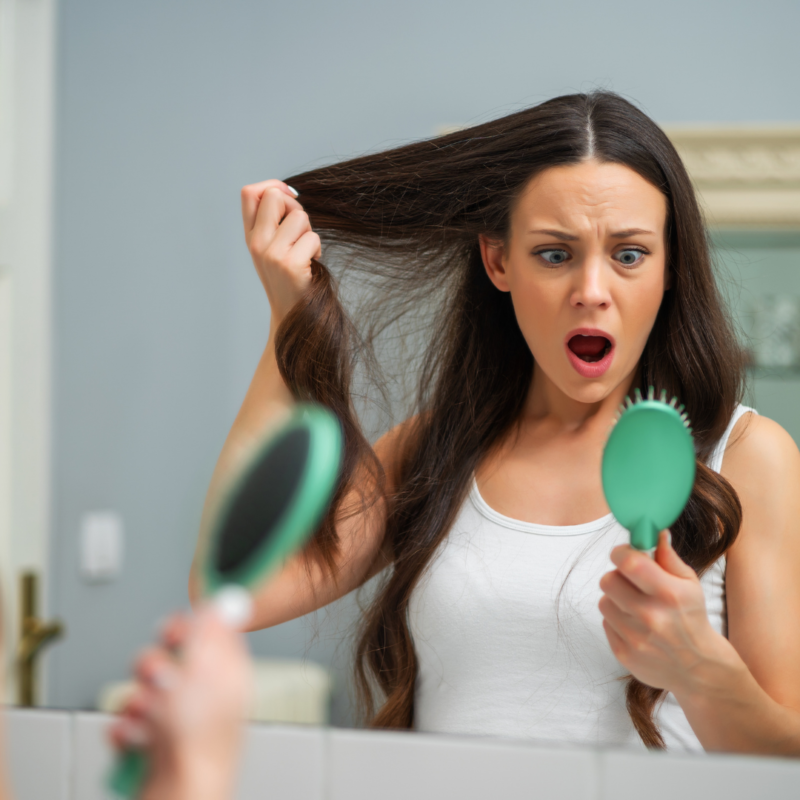

by
|
Hair 101: How normal, healthy hair grows To understand what causes hair loss for men and women, let’s first look at how healthy hair grows. Normal, healthy hair grows and dies in three phases, which include:
It’s completely normal to shed 50 to 100 hairs per day. When shedding becomes significant—clumps of hair found on your pillow, clogging the shower drain (especially if you have long hair), landing on the counter or in your food—it’s time to see a healthcare practitioner.
Hair shedding can be caused by a variety of factors—from age, genetics, stress and disease to medication, hormonal imbalance and nutrient deficiencies. Some common causes of hair shedding include:
With this information and lab tests in hand, the practitioner can identify the probable cause of hair shedding and prescribe treatment. If you treat the root cause early on, you may be able to prevent unnecessary or permanent hair loss. Patients often ask us: Can hair regrow after hair falls out? Prompt treatment of hair shedding is critical because once the hair follicle is dead it won’t produce hair ever again. Fortunately, there are many treatment options available if you’re wondering what should we do to regrow hair, speed up hair growth or make hair healthier. We’ll share some effective treatment options later in this blog. While hormones do help promote healthy hair growth, when the body produces too much or too little of certain hormones hair production can get out of whack. Proper hormone balance also supports healthy hair growth during the anagen phase (the 3-year phase when hair actively grows). Thyroid hormones advance the onset of this phase and increase the rate of hair growth. Estrogens prolong the anagen phase but decrease growth rate.

One of the most common forms of hair loss, the U.S. National Library of Medicine estimates that pattern hair loss (PHL) affects about 50 million men and 30 million women in the U.S. Those with pattern hair loss experience chronic, gradual hair loss over time.
Over production of androgens is usually the cause of androgenetic alopecia. Androgens are a type of hormone that supports normal sexual development in men. Androgen levels also play a role in healthy sex drive and the regulation of hair growth in both women and men.
The condition has been shown to have a genetic component, as it often runs in families that tend to convert testosterone into DHT (dihydrotestosterone). DHT helps hair grow on most of the body but not on the scalp. High DHT levels cause hair follicles to miniaturize and weaken, so hair falls out.
In men with PHL, the hairline recedes starting above the temples and progresses to thinning on the top of the head. This results in an “M”-shaped hairline, which may advance to partial or complete baldness. A number of health conditions have been tied to male pattern hair loss. These include prostate cancer, which has similar risk factors, as well as conditions such as diabetes, obesity, cardiovascular disease and high blood pressure. For women with PHL, thinning usually occurs over the entire head and rarely results in a receding hairline or complete baldness. While thinning hair can be traumatic for women, the term female pattern baldness is a bit of a misnomer. Female pattern hair loss has also been linked to polycystic ovary syndrome (PCOS).

In men with PHL, the hairline recedes starting above the temples and progresses to thinning on the top of the head. This results in an “M”-shaped hairline, which may advance to partial or complete baldness. A number of health conditions have been tied to male pattern hair loss. These include prostate cancer, which has similar risk factors, as well as conditions such as diabetes, obesity, cardiovascular disease and high blood pressure. For women with PHL, thinning usually occurs over the entire head and rarely results in a receding hairline or complete baldness. While thinning hair can be traumatic for women, the term female pattern baldness is a bit of a misnomer. Female pattern hair loss has also been linked to polycystic ovary syndrome (PCOS).
Women with PCOS (a type of hormone imbalance) often suffer from acne, irregular periods, hirsutism (excess hair on face, chest and back) and weight gain.
Patients often ask me, “Do testosterone boosters cause hair loss?” In general, just about any type of hormone imbalance can cause hair shedding. This is the case for patients with high levels of DHT, which can cause male and female pattern hair loss as described above. So, are you becoming bald due to high testosterone level? No. High levels of DHT may cause hair loss but testosterone therapy itself does not cause baldness.
That being said, some people may experience temporary hair shedding after starting hormone therapy but it’s not due to higher testosterone or estrogen levels.
Most patients who come to us with low T or estrogen imbalance also suffer from nutritional deficiencies. Both hormone imbalances and nutrient deficiencies may cause hair to go dormant. That means hair isn’t growing OR falling out like it does during a healthy hair cycle.
Once you optimize necessary hormones, vitamins and other nutrients, the hair wakes up and wants that dead, brittle hair to hit the road. This can lead to rapid hair shedding—including all of the old, dead hair that lingered past its expiration date. This is a temporary condition known as telogen effluvium, which can last several months.
While many people errantly assume high testosterone levels cause hair shedding, high DHT levels and telogen effluvium are often the culprit. Of the two, telogen effluvium is much more common. For every instance of high DHT levels we see in our practice, we’ll see 40 cases of telogen effluvium.
To minimize the risk of rapid hair shedding due to telogen effluvium it’s essential to properly optimize hormones (testosterone, estrogen, progesterone and thyroid), vitamins (especially vitamins D, B12) and other nutrients (iron). Experienced practitioners will perform lab tests to get a baseline, and optimize levels from there.
Research shows that thyroid hormones T3 and T4 have a direct impact on how human hair follicles function. Significant thyroid hormone imbalances—both hyperthyroidism (overactive thyroid) and hypothyroidism (underactive thyroid)—can cause hair shedding.
It’s important to work with a knowledgeable practitioner who understands how to treat thyroid issues, so you can get the proper treatment. Fortunately, hair shedding usually can be resolved once thyroid conditions are treated and T3 and T4 levels are back in check.
Learn how EVEXIAS approaches thyroid health here.

What’s the reason for losing hair? There are many other reasons people shed hair besides those discussed above (hormone imbalance, high BP hair loss, vitamin deficiency, etc.). We frequently receive questions at our clinics on the topic of hair shedding. Perhaps I can answer one of your questions here.

Lower levels of estrogen and progesterone that occur during menopause can lead to hair shedding more than normal. In addition, women who experience female pattern hair loss usually don’t notice hair thinning until menopause begins, so they may associate hair loss with menopause.
Younger women may experience hair shedding due to many of the conditions mentioned above. You may lose hair in your 20s due to PCOS (polycystic ovary syndrome), hormone imbalance, genetics, diabetes and a host of other conditions.
It’s unlikely that frequent haircuts cause hair loss because you’re cutting the hair shaft, not compromising the follicle. However, how you treat, color, style and care for your hair does matter. Hair styles that pull on the hair, like tight ponytails or cornrows could cause traction alopecia and permanent hair loss. Some hair treatments like excessive coloring and permanents may also cause hair to shed.
Yes! I see this frequently in my practice, and it doesn’t matter if it’s bad stress or good stress. I’ve seen wedding planning take a toll on many brides’ hair over the years.
Vitamins D and B12 play critical roles in supporting healthy hair growth. Vitamin D helps initiate the anagen phase and supports hair follicle health. Vitamin B12 helps promote the production of red blood cells, which helps hair follicles thrive. How about biotin does it work and collagen does it work? Depending on the patient’s needs, he or she may benefit from supplements containing nutrients like biotin (vitamin B7), collagen peptides, saw palmetto, shilajit and others. Your practitioner can help you weigh options.
Vitamins D and B12 play critical roles in supporting healthy hair growth. Vitamin D helps initiate the anagen phase and supports hair follicle health. Vitamin B12 helps promote the production of red blood cells, which helps hair follicles thrive. How about biotin does it work and collagen does it work? Depending on the patient’s needs, he or she may benefit from supplements containing nutrients like biotin (vitamin B7), collagen peptides, saw palmetto, shilajit and others. Your practitioner can help you weigh options.
It all depends on what caused your hair to shed in the first place. Hair may grow back naturally once you discontinue medication or treatments for cancer and other diseases that cause hair shedding. Other forms of hair loss may require treatment by a dermatologist (scalp infections, psoriasis and inflammation). At EVEXIAS, we offer a variety of treatments for hair loss or shedding, which may include:
